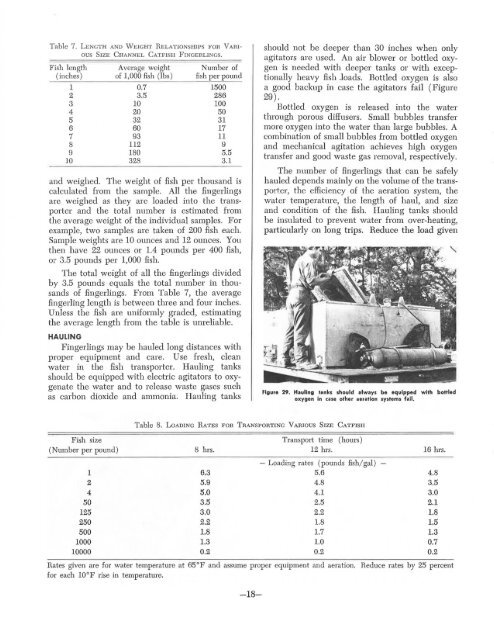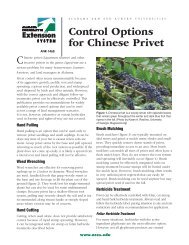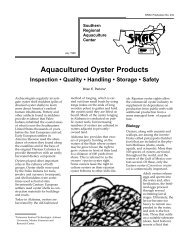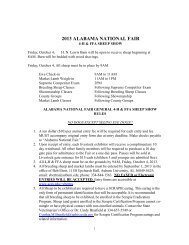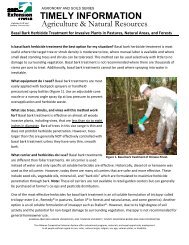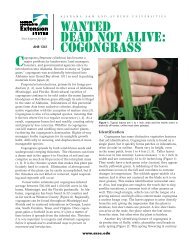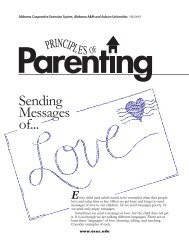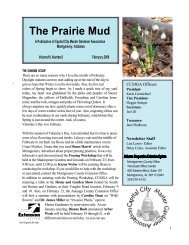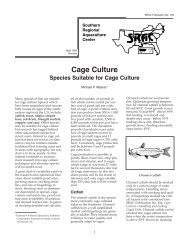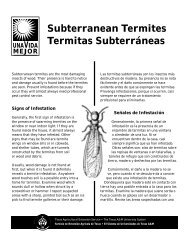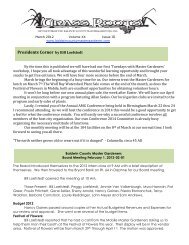PRODUCING - Alabama Cooperative Extension System
PRODUCING - Alabama Cooperative Extension System
PRODUCING - Alabama Cooperative Extension System
Create successful ePaper yourself
Turn your PDF publications into a flip-book with our unique Google optimized e-Paper software.
Table 7. LENGTH AND WEIGHT RELATIONSHIPS FOR VARIous<br />
SIZE CHANNEL CATFISH FINGERLINGS.<br />
Fish length<br />
(inches)<br />
1<br />
2<br />
3<br />
4<br />
5<br />
6<br />
7<br />
8<br />
9<br />
10<br />
Average weight<br />
of 1,000 fish (lbs)<br />
0.7<br />
3.5<br />
10<br />
20<br />
32<br />
60<br />
93<br />
112<br />
180<br />
328<br />
Number of<br />
fish per pound<br />
1500<br />
286<br />
100<br />
50<br />
31<br />
17<br />
11<br />
9<br />
5.5<br />
3.1<br />
and weighed. The weight of fish per thousand is<br />
calculated from the sample. All the fingerlings<br />
are weighed as they are loaded into the transporter<br />
and the total number is estimated from<br />
the average weight of the individual samples. For<br />
example, two samples are taken of 200 fish each.<br />
Sample weights are 10 ounces and 12 ounces. You<br />
then have 22 ounces or 1.4 pounds per 400 fish,<br />
or 3.5 pounds per 1,000 fish.<br />
The total weight of all the fingerlings divided<br />
by 3.5 pounds equals the total number in thousands<br />
of fingerlings. From Table 7, the average<br />
fingerling length is between three and four inches.<br />
Unless the fish are uniformly graded, estimating<br />
the average length from the table is unreliable.<br />
HAULING<br />
Fingerlings may be hauled long distances with<br />
proper equipment and care. Use fresh, clean<br />
water in the fish transporter. Hauling tanks<br />
should be equipped with electric agitators to oxygenate<br />
the water and to release waste gases such<br />
as carbon dioxide and ammonia. Hauling tanks<br />
should not be deeper than 30 inches when only<br />
agitators are used. An air blower or bottled oxygen<br />
is needed with deeper tanks or with exceptionally<br />
heavy fish .loads. Bottled oxygen is also<br />
a good backup in case the agitators fail (Figure<br />
29).<br />
Bottled oxygen is released into the water<br />
through porous diffusers. Small bubbles transfer<br />
more oxygen into the water than large bubbles. A<br />
combination of small bubbles from bottled oxygen<br />
and mechanical agitation achieves high oxygen<br />
transfer and good waste gas removal, respectively.<br />
The number of fingerlings that can be safely<br />
hauled depends mainly on the volume of the transporter,<br />
the efficiency of the aeration system, the<br />
water temperature, the length of haul, and size<br />
and condition of the fish. Hauling tanks should<br />
be insulated to prevent water from over-heating,<br />
particularly on long trips. Reduce the load given<br />
Figure 29. Hauling tanks should always be equipped with bottled<br />
oxygen in case other aeration systems fail.<br />
Table 8. LoADING RATES FOR TRANSPORTING VARIOus SizE CATFISH<br />
Fish size Transport time (hours)<br />
(Number per pound) 8 hrs. 12 lm. 16 hrs.<br />
- Loading rates (pounds fish/gal)<br />
1 6.3 5.6 4.8<br />
2 5.9 4.8 3.5<br />
4 5.0 4.1 3.0<br />
50 3.5 2.5 2.1<br />
125 3.0 2.2 1.8<br />
250 2.2 1.8 1.5<br />
500 1.8 1.7 1.3<br />
1000 1.3 1.0 0.7<br />
10000 0.2 0.2 0.2<br />
Rates given are for water temperature at 65°F and assume proper equipment and aeration. Reduce rates by 25 percent<br />
for each 10°F rise in temperature.<br />
-18-


